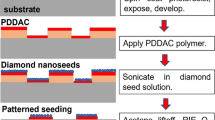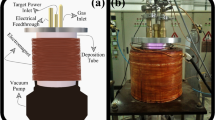Abstract
In nuclear reaction experiments, the thin targets are required. In the present work, 30 thin 116Sn targets were prepared using physical vapor deposition technique (preferable for thin film fabrication) on carbon backing with usage efficiency of 98%. The carbon-backed thin target films along with the parting agents are deposited on the particular substrates using a diffusion pump based coating unit. The thicknesses of the targets were verified using α-energy loss and RBS technique and they were in good agreement with each other. The purity of the target, verified using RBS, EDS and XRD techniques, were also tested with confirmation.





Similar content being viewed by others
References
Banerjee T, Abhilash SR, Kabiraj D, Ojha S, Umapathy GR, Shareef M, Laveen PV, Duggal H, Amarnadh RU, Gehlot J, Nath S, Mehta D (2017) Fabrication of thin targets for nuclear reaction studies at IUAC. Vacuum 144:190–198
Mahajan R, Abhilash S, Sharma P, Kaur G, Kabiraj D, Duggal H, Mehta D, Behera B (2018) Thin targets for nuclear reaction studies using NAND facility. Vacuum 150:203–206
Singh V, Abhilash S, Behera B, Kabiraj D (2011) Fabrication of thin self-supporting platinum targets using evaporation techniques. Nucl Instrum Methods Phys Res Sect A Accel Spectrom Detect Assoc Equip 635(1):20–23
Kalkal S, Abhilash S, Kabiraj D, Mandal S, Madhavan N, Singh R (2010) Fabrication of 90,94Zr targets on carbon backing. Nucl Instrum Methods Phys Res Sect A Accel Spectrom Detect Assoc Equip 613(2):190–194
Zell KO (1982) Newsletter, vol. 9, no. 1 International Nuclear Target Development Society, p 6
Manente G, Pengo R (1989) Preparation by rolling of thin cadmium and tin foils and cadmium/lead and tin/lead bonded targets. Nucl Inst Methods Phys Res A 282:140–141
Abhilash S, Gehlot J, Banerjee T, Selvakumar K, Kaur J, Kabiraj D (2015) Recent target development activities at inter-university accelerator centre. J Radioanal Nucl Chem 305(3):749–753
Sood A, Umapathy GR, Sharma A, Abhilash SR, Ojha S, Kabiraj D, Banerjee A, Singh PP (2020) Self-supporting thin tin targets fabricated by ultra-high vacuum evaporation for heavy-ion induced reactions. Vacuum 172:109107
Singh A, Shukla A, Singh D, Abhilash SR, Kabiraj D, Avasthi DK (2009) Isotopic Sn target fabrication at IUAC. Proc Int Symp Nucl Phys 54:706–707
Sharma P, Abhilash S, Behera BR, Kabiraj D (2014) Preparation of thin 122Sn targets at IUAC. Proc DAE Symp Nucl Phys 59:912–913
Giri PK, Linda SB, Singh D, Abhilash SR, Kumar H, Kumar R, Muralithar S, Singh RP, Kabiraj D (2015) Fabrication of thin 124Sn target on Al-backing using vacuum evaporation technique at IUAC, New Delhi. Proc DAE Symp Nucl Phys 60:984–985
Ali S, Pai H, Rajbanshi S, Ray P, Roy S, Goswami A (2017) Fabrication of 112Sn target on 208Pb-backing. Proc DAE Symp Nucl Phys 62:1132–1133
Pai H, Ali S, Rajbanshi S, Ray P, Roy S, Goswami A (2019) 112Sn target: fabrication, characterization and application. Vacuum 167:393–396
Sinha AK, Madhavan N, Das JJ, Sugathan P, Kataria DO, Patro AP, Mehta GK (1994) Heavy ion reaction analyzer (HIRA): a recoil mass separator facility at NSC. Nucl Instrum Methods A 339:543–549
Deb NK, Kalita K, Abhilash SR, Giri PK, Biswas R, Umapathy GR, Kabiraj D, Chopra S (2019) Fabrication and characterization of thin targets of nickel (61,62Ni) isotopes by physical vapour deposition technique for nuclear reaction studies. Vacuum 163:148–157
Rohilla A, Gupta CK, Rajbongshi T, Singh RP, Ojha S, Duggal H, Mehta D, Chamoli SK (2015) Fabrication of enriched 174Yb2O3 thin targets on carbon and tantalum backings. Nucl Inst Methods Phys Res A 797:230–233
Behrndt K, Love R (1962) Automatic control of film-deposition rate with the crystal oscillator for preparation of alloy films. Vacuum 12(1):1–9
Braski DN (1972) A study of various parting agents for producing self-supporting thin films. Nucl Instrum Methods 102(3):553–566
Hosamani MM, Abhilash SR, Ojha S, Umapathy GR, Badiger NM, Kabiraj D (2019) Fabrication and characterization of targets of oxidizing materials for heavy ion nuclear reaction experiments. J Instrum 14:P01007
Freund LB, Suresh S (2004) Thin film materials: stress, defect formation and surface evolution. Cambridge University Press, Cambridge
Rajesh KK, Musthafa MM, Hosamani MM, Shamlath A, Abhilash SR, Kabiraj D (2017) Fabrication of carbon sandwiched thin targets of 138Ba by evaporation technique. Vacuum 141:230–234
Yaffe L (1962) Preparation of thin films, sources, and targets. Annu Rev Nucl Sci 12(1):153–188
Sahoo RN, Jyothi GN, Sood A, Abhilash SR, Umapathy GR, Kabiraj D, Ojha S, Rao PVM, Singh PP (2019) Fabrication of thin 130Te target foils for sub-barrier fusion studies. Nucl Inst Methods Phys Res A 935:103–109
Ziegler JF, Biersack JP, Ziegler MD (2008) SRIM: a the stopping and range of ions in matter. SRIM Co, Chester. ISBN 0-9654207-1-X. http://www.SRIM.org
Sharma R, Umapathy GR, Kumar P, Ojha S, Gargari S, Joshi R, Chopra S, Kanjilal D (2019) Ams and upcoming geochronology facility at inter university accelerator centre (IUAC), New Delhi, India. Nucl Instrum Methods Phys Res Sect B Beam Interact Mater Atoms 438:124–130
Chu W-K, Mayer JW, Nicolet MA (1978) Backscattering spectroscopy
Doolittle L (1985) Rump: rutherford backscattering spectroscopy analysis package. Nucl Instrum Methods Phys Res Sect B 9:344
Salamat A, Briggs R, Bouvier P, Petitgirard S, Dewaele A, Cutler ME, Corà F, Daisenberger D, Garbarino G, McMillan PF (2013) High-pressure structural transformations of Sn up to 138 gPa: angle-dispersive synchrotron X-ray diffraction study. Phys Rev B 88(10):104104–1
Wolcyrz M, Kubiak R, Maciejewski S (1981) X-ray investigation of thermal expansion and atomic thermal vibrations of tin, indium, and their alloys. Phys Status Solidi (b) 107(1):245–253
Neykov N, Peneva S, Djuneva K (1992) Electrochemically obtained tin—Part II. Zeitschrift für Kristallographie Cryst Mater 202(1–4):215–226
Hassel O, Mark H (1924) Über die kristallstruktur des graphits. Zeitschrift für Physik 25(1):317–337
Acknowledgements
Authors are thankful to Dr. D. Kanjilal, IUAC for extending FESEM facility, procured under Geochronology Project [MoES/P.O.(Seismic)8(09) Geochron/2012]. Authors are also thankful to Dr. Sunil Ojha, IUAC, for the help and support extended towards RBS and EDS characterizations; Health Physics Department, IUAC for providing the strong radioactive source and Mr. Dipak Das on behalf of the Sophisticated Analytical Instrument Facility (SAIF)—XRD, Department of Intrumentation and USIC, Gauhati University, Guwahati—14, Assam. Authors also thank Mr. M. M. Hosamani, Karnatak University, and Dr. Mausumi Das, Gauhati University, for fruitful suggestions regarding this work. One of the authors (N. K. Deb) gratefully acknowledges the Council of Scientific and Industrial Research (CSIR) (Grant No. 09/059(0056)/2014-EMR-I), New Delhi for the award of junior research fellowship in order to carry out this work.
Author information
Authors and Affiliations
Corresponding author
Rights and permissions
About this article
Cite this article
Deb, N.K., Kalita, K., Giri, P.K. et al. Carbon-backed thin tin (116Sn) isotope target fabrication by physical vapor deposition technique. J Radioanal Nucl Chem 326, 97–104 (2020). https://doi.org/10.1007/s10967-020-07316-0
Received:
Published:
Issue Date:
DOI: https://doi.org/10.1007/s10967-020-07316-0




